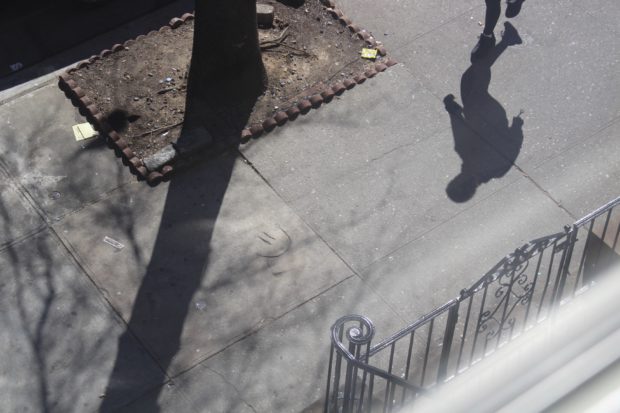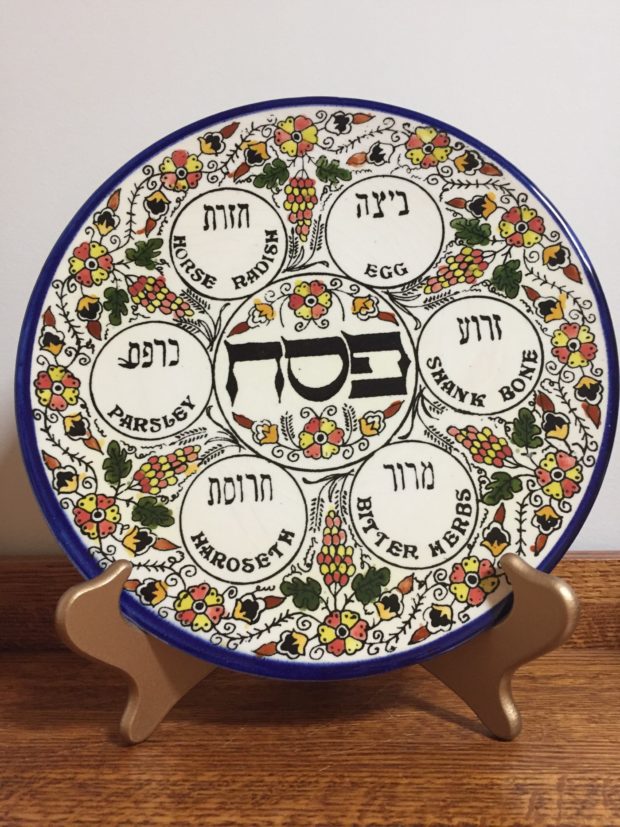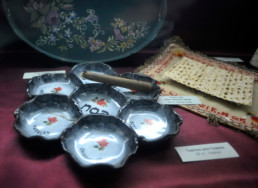Aria for the Bounty outside my window after Sharon Olds
Reflection Through Poetry
Aria for the Bounty outside my window
after Sharon Olds
Kate Cammell | kac2261@columbia.edu

I’d never noticed that there
are twelve of them on my block, trees
with branches like varicose veins, twisted
toward sky. Their nakedness
casting soft linear shadows
on the sidewalk. When
had their leaves fallen? I’d been
so damn busy in Autumn. I
can’t even remember
what color they turned. Perhaps
orange, but I couldn’t name
the hue. Maybe a shade like
campfire or papaya innards? But
now, I suppose, I’ll have time
to watch buds appear and to make
up for not knowing
which railings birds prefer
for perching on the wrought
iron fence across the street. I
can wake up and sit
in the light of my bay window
and notice the man wearing
a corduroy jacket buttoned
halfway up, his beret tilted
slightly—it’s important
to look crisp in a crisis
I think, letting ourselves pretend
in whatever way we
can to have control, sometimes
we need that. This morning
I made coffee and drank it
out of a pale pink Ikea
mug, then I did something
unbecoming of the New
Yorker I’d convinced
myself I am, I waved to people
rolling their metal carts
down the street, having just
pillaged shelves of the Harlem
Costco one block down. I
stood inches from
the glass, to be closer
to them and so I could
taste my own breath
bouncing back at me, a reminder
that I am alive. Every so often
a car honks their horn
at the nearby intersection and I’ll let
myself believe that they’re saying
hello to me. Saying we see you
by the window and we
are in this together. I’ve
started smiling back
at the face someone carved
in wet cement, now frozen
forever on the sidewalk below
my window. Yesterday, a
man strolled by after a successful
supply run, his cart bursting
with Bounty paper towel
packaged in groups of six, nestled
in plastic covering, ready
to provide—mental manna
for indefinite isolation. The man rested
his hand atop the package, perhaps
for stability but I saw
what I wanted. And
that was a gentle touch. Like
a measure reserved for loved
ones, and it was comforting
to think of being touched
as I looked out at a street
where people were speed-walking
to the safety of a home, their
Bounty in tow
Dispatch from a Pandemic Passover
As published in Columbia Journalism
Dispatch from a Pandemic Passover
Jane R. Eisner | jre17@columbia.edu

This year, Passover is stripped to its essence.
This has always been my favorite holiday: a weeklong religious ritual with grand, universal themes anchored by a Seder meal that encourages song, schmoozing, discussion, debate, and inter-generational sharing.
Passover is spring and renewal. It is brisket and matzo ball soup. It is, if you keep a kosher home and host two big Seders, as I traditionally have, utterly exhausting and absolutely worth it.
But this year, the very commandment to gather has been erased. Our family once held Seders with 25 people in our spacious, suburban dining room, arranging four tables to fashion a huge circle, unwieldy and glorious. Even in a New York City apartment, we managed to cram 18 people around a long, extended table, friends and family and the occasional stranger, all taking the journey together late into the night.
Not this year. This year, it’s just me and my husband, hoping to connect with children, siblings and friends across spotty Internet lines.
A family member is living in our city apartment and we are in our upstate home without all our usual Passover paraphernalia, and I miss it terribly. The English cutlery I inherited from my parents and only use this special week will stay in its locked cabinet. The elegant Elijah’s cup my late father gave me on the shelf. I won’t bring out the plague puppets and noisy toy frogs I’ve collected over the years for children’s entertainment, nor the colorful matzo covers the kids made in day school.
These precious objects represent the holiday, but they are not its essence.
I used to spend hours setting the table. It will take a mere moment when we sit down on Wednesday night, just the two of us.
And so what? I cannot lament the loss of things when all around us people are losing lives and loved ones. We still have the Seder. We still have the story.
The questions raised by the Exodus story, recounted in the Haggadah, take on added urgency and relevance in light of the COVID-19 pandemic. What does it mean to be free when we are confined? How do we maintain our identity and our communal associations in isolation? How do we nourish hope when we may well face the modern-day equivalent of wandering the desert for forty more years?
The Haggadah is infused with gratitude to God for enabling an oppressed people to break free. Many of us are grateful simply to breathe each morning. What are we learning about ourselves? How will we make our society healthier, kinder and more just when this is finally over?
I’ve never experienced a Passover of such hardship, but the Jewish people have endured worse, and there’s comfort in knowing that.
I fervently hope we will gather next spring, that I will fuss about the price of brisket and the state of my matzo balls, that I will spend hours setting the cutlery and decorating the table with all the items I’ve collected, that we will study the text and dream of drawing new meanings from it.
It won’t be the same, because we won’t be the same. Once we have had to focus on the essence of the holiday, we will know that what matters most is the story we recite year after year, together.
Sometimes the Body of Christ is a Chocolate Chip Pancake
Sometimes the Body of Christ is a Chocolate Chip Pancake
Madeline Simpson | mms2331@columbia.edu

Associate Pastor David Gungor opens Trinity Grace Church’s service with worship songs. He plays an acoustic guitar, his wife plays the violin, and three other people sing harmony. They all stand at least six feet apart from each other.
After worship, Pastor Michael Rudzena enters the stage and gives a sermon about the biblical character Lazarus, who Jesus raised from the dead. Rudzena speaks of Jesus’ intellectual depth, his emotional intelligence and his hopeful courage as he learns about and mourns his friend’s death. Rudzena addresses an empty chapel.
The service flows from sermon to Eucharist, the Christian tradition of eating bread and drinking wine to honor Jesus’ body and blood. On a typical Sunday, the congregation would approach the front of the church to receive Eucharist from the pastor or church member.
But I know that today is different. I am not in Good Shepherd Chapel, where Trinity Grace holds service—I’m in my parent’s living room in White Bear Lake, Minnesota, watching Rudzena on a flat-screen TV. Instead of wine and bread, I have coffee and a piece of a chocolate chip pancake.
“Last week we said this is the weirdest Eucharist we’ve ever done,” Rudzena says. “But here we are again. Communion is about our connection to each other. Though we are not in the same room, we are deeply connected, not only by God’s spirit but by our love for each other.”
Trinity Grace is one of thousands of houses of worship in the United States and around the world impacted by the coronavirus. On March 21, the White House issued an ordinance for Americans to avoid gatherings of 10 or more people. Most evangelical church services fall in this category, and churches around the nation scrambled to set up technology that would allow the community to continue to meet.
It is the second Sunday in a row that I am attending “virtual church”—a result of social distancing and the “stay-at-home” orders to protect from the COVID-19 virus. The service is aired live on Trinity Grace’s YouTube channel, with a chat capability where congregants can talk in real-time throughout the sermon. I learn that I am not the only one watching out of town.
“Greetings from Baltimore!”
“Hello from two blocks away in Tribeca!”
“Grace and peace, everybody.”
For my church-going family, spending a Sunday morning at home usually meant a snowstorm had shut roads down. Raised in a conservative evangelical home, I grew up going to church a few times a week, including every Sunday morning. Skipping church was not allowed.
But now, we have no choice. My parents’ local church in Minnesota closed in the same way that the churches in New York did. There is nowhere to go on Sunday mornings except YouTube.
We adjust as the world adjusts.
“Let’s let this table move us towards unity in a time of strife,” Rudzena says, leading the online congregation in the Eucharist liturgy. “Let’s join in prayer, and start with gratitude. The Lord is here. His Spirit is with us... We lift our hearts to the Lord… It is right to give thanks and praise.”
And then, around the country, we eat our chocolate chip pancake, our cracker, our sourdough bread, and drink our wine, our coffee, our juice. We recite, separately but together, “Jesus Christ is holy. Jesus Christ is Lord. To the glory of God the Father. Amen.”



